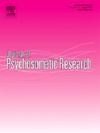躯体症状负担、创伤后应激障碍和分离:来自995名国际女性心理健康服务使用者的横断面研究结果
IF 3.3
2区 医学
Q2 PSYCHIATRY
引用次数: 0
摘要
目的躯体症状负担常与创伤性精神病理相关;然而,PTSD、自组织障碍(DSO)和分离的具体作用仍未得到充分探讨。本研究调查女性心理健康服务使用者的躯体症状负担,并评估创伤相关症状与躯体症状负担之间的关系。方法来自国际临床机构的女性参与者(N = 995)完成了评估躯体症状(SSS-8)、儿童创伤(BBTS)、PTSD和DSO症状(ITQ)和分离(MDI)的有效自我报告。结果超过一半(54.9%)的患者报告躯体症状负担升高(SSS-8≥13)。这些个体更有可能筛查出可能的ICD-11 PTSD/CPTSD阳性(62.6% vs 28.3%), X2 (1) = 116.685,p <;0.001、Φ= 0.34和报告解离症状(61.5% vs 16.0%), X2 (1) = 210.883, p & lt;0.001,Φ = 0.46,与躯体症状负担较低的患者相比。分层回归显示,PTSD、DSO和分离在躯体症状负担的方差中占比超过人口统计学和儿童创伤暴露的32%。Logistic回归证实PTSD (OR = 1.54)、DSO (OR = 1.67)和解离(OR = 2.08)均与躯体症状负担升高显著相关(均为ps <;0.001)。最终模型具有良好的分类性能(准确率为75.1%,AUC = 0.824),显著优于个体症状模型。结论女性临床人群创伤相关症状与躯体症状密切相关。研究结果强调需要创伤知情的筛查和治疗,以有效地识别躯体症状障碍和管理躯体症状在精神卫生机构。本文章由计算机程序翻译,如有差异,请以英文原文为准。
Somatic symptom burden, PTSD, and dissociation: Cross-sectional findings from 995 international female mental health service users
Objective
Somatic symptom burden is frequently linked to trauma-related psychopathology; Yet, the specific contributions of PTSD, disturbances in self-organization (DSO), and dissociation remain underexplored. Our study examined the prevalence of somatic symptom burden among female mental health service users and evaluated the associations between trauma-related symptoms and somatic symptom burden.
Methods
Female participants (N = 995) from international clinical settings completed validated self-report measures assessing somatic symptoms (SSS-8), childhood trauma (BBTS), PTSD and DSO symptoms (ITQ), and dissociation (MDI).
Results
Over half (54.9 %) reported elevated somatic symptom burden (SSS-8 ≥ 13). These individuals were significantly more likely to screen positive for probable ICD-11 PTSD/CPTSD (62.6 % vs 28.3 %), X2 (1) = 116.685,p < 0.001,Φ = 0.34, and report dissociative symptoms (61.5 % vs 16.0 %), X2 (1) = 210.883,p < 0.001,Φ = 0.46, compared to those with lower somatic symptom burden. Hierarchical regression revealed that PTSD, DSO, and dissociation accounted for an additional 32 % of variance in somatic symptom burden beyond demographics and childhood trauma exposure. Logistic regression confirmed that PTSD (OR = 1.54), DSO (OR = 1.67), and dissociation (OR = 2.08) were each significantly associated with elevated somatic symptom burden (all ps < 0.001). The final model demonstrated good classification performance (accuracy = 75.1 %, AUC = 0.824) and significantly outperformed individual symptom models.
Conclusion
Trauma-related symptoms are closely linked to somatic symptoms among female clinical populations. Findings emphasize the need for trauma-informed screening and treatment to effectively identify Somatic Symptom Disorders and manage somatic symptoms in mental health settings.
求助全文
通过发布文献求助,成功后即可免费获取论文全文。
去求助
来源期刊
CiteScore
7.40
自引率
6.40%
发文量
314
审稿时长
6.2 weeks
期刊介绍:
The Journal of Psychosomatic Research is a multidisciplinary research journal covering all aspects of the relationships between psychology and medicine. The scope is broad and ranges from basic human biological and psychological research to evaluations of treatment and services. Papers will normally be concerned with illness or patients rather than studies of healthy populations. Studies concerning special populations, such as the elderly and children and adolescents, are welcome. In addition to peer-reviewed original papers, the journal publishes editorials, reviews, and other papers related to the journal''s aims.

 求助内容:
求助内容: 应助结果提醒方式:
应助结果提醒方式:


